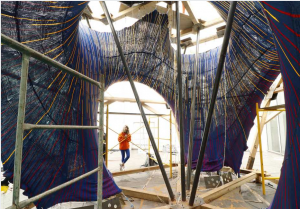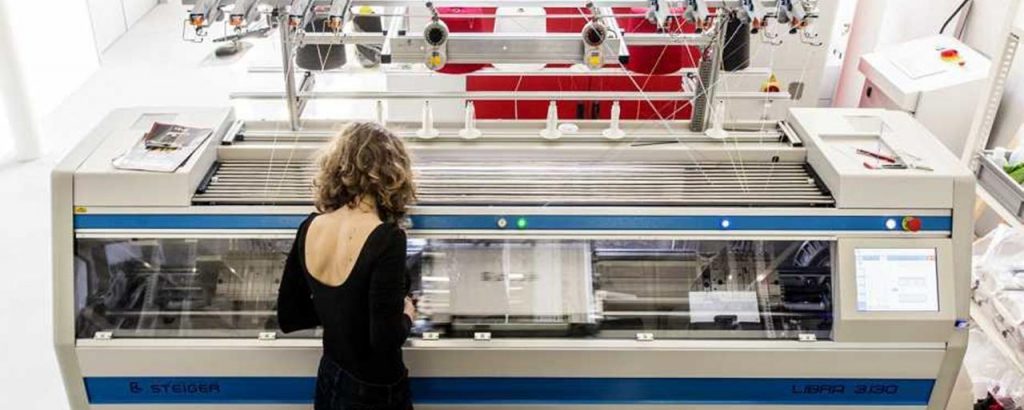In Mexico City, a strange structure has been erected – it looks a bit like a crouching frog, or maybe an exotic flower. It was built using a special 3D knitting technique developed at ETH Zurich. The structure, called KnitCandela, is partially made from concrete, but its formwork is a knitted textile supported by a steel cable-net. The project, an homage to Spanish-Mexican architect Felix Candela, is a collaboration with Zaha Hadid Architects Computation and Design Group and Architecture Extrapolated.
3D knitting has been used before to produce things like clothing and furniture, but it isn’t often seen on this large of a scale. It took 36 hours for an industrial knitting machine to produce the shuttering of the formwork for the shell structure, following a digital pattern. The fully shaped, double-layered textile was knitted in four long strips, with the lower layer forming the visible ceiling. The upper layer contains sleeves for the cables of the formwork system and pockets for balloons. After the structure is coated in concrete, the balloons are popped, leaving hollow spaces that help save on material and weight.
The structure was erected in the courtyard of a museum; the knitted formwork was tensioned between a temporary boundary frame and sprayed with a specially formulated cement mixture, just a few millimeters thick. Once it hardened, conventional fiber-reinforced concrete was applied. The knitted fabric, which was brought to Mexico City inside normal suitcases, weighs about 25 kilograms and the cable around 30 kilograms. Together, they are able to support more than five tonnes of concrete.
KnitCandela’s technology was developed by Mariana Popescu, a doctoral student with Philippe Block, Professor of Architecture and Structure at ETH Zurich, and Lex Reitier, a doctoral student with Robert Flatt, Professor of Physical Chemistry of Building Materials. The technology is an evolution of the flexible forming technology developed for the HiLo roof, which the Block group developed for Empa’s NEST research and innovation building in 2017. Unlike the HiLo roof, which was made of a network of cables and a sewn textile, KnitCandela’s knitted shell was produced in one go.
 Using knitted textiles in construction simplifies the construction process for complex shapes, and also cuts down on material, labor and waste. It’s a lot faster, too.
Using knitted textiles in construction simplifies the construction process for complex shapes, and also cuts down on material, labor and waste. It’s a lot faster, too.
“It took only five weeks from the initial work until completion – much less time than if we were using conventional technology,” said Matthias Rippmann, project manager for KnitCandela and senior researcher in the Block Research Group.
While 3D printing is being pursued with interest in the construction industry right now, 3D knitting is a new idea, but a promising one. Giant robotic 3D printers aren’t required for 3D knitting a structure like KnitCandela, either – all that is needed is a conventional knitting machine.
“Knitting offers a key advantage that we no longer need to create 3D shapes by assembling various parts,” said Popescu. “With the right knitting pattern, we can produce a flexible formwork for any and all kinds of shell structures, pockets and channels just by pressing a button.”
Discuss this and other 3D printing topics at 3DPrintBoard.com or share your thoughts below.
[Source/Images: ETH Zurich]



37 Replies to “Concrete and 3D Knitting Combine to Produce KnitCandela 3D Printed Structure”
Comments are closed.